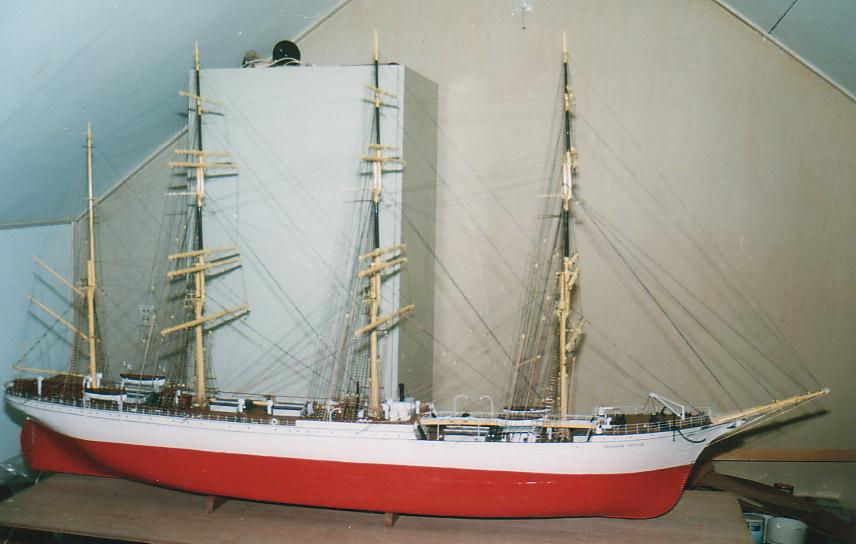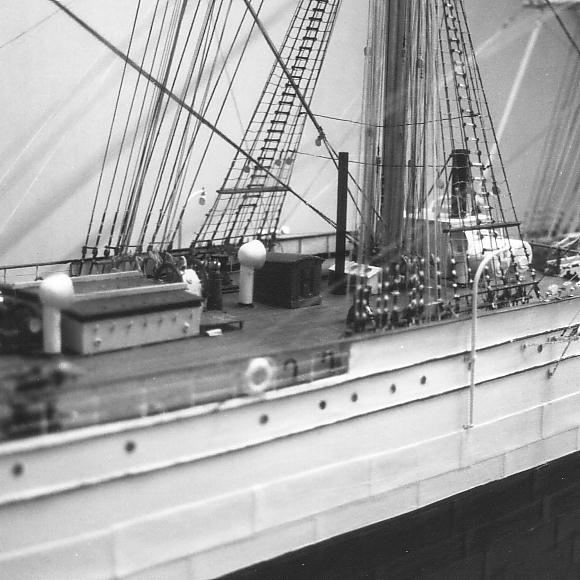During his visit to the Galapagos Islands in 1835 Charles Darwin was told by the Ecuadorian
governor of the islands that giant tortoises, Geochelone elephantopus, of different
islands had different sizes and shapes (Darwin, 1859). Darwin's conclusion was that these
differences were the results of natural selection under different environmental circumstances.
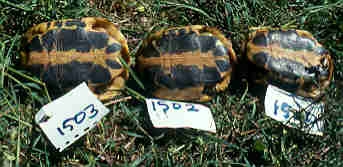 In the Balkans Testudo hermanni is the most common tortoise species. It is found all
over Greece from sea level to up 1500 metres in the mountains of the Peloponnese
(Willemsen & Hailey, 1989).
Greece is divided into many
regions, each with different climatic conditions and habitats, by mountain ridges which are
impassable (or only with difficulty) by tortoises.
In the Balkans Testudo hermanni is the most common tortoise species. It is found all
over Greece from sea level to up 1500 metres in the mountains of the Peloponnese
(Willemsen & Hailey, 1989).
Greece is divided into many
regions, each with different climatic conditions and habitats, by mountain ridges which are
impassable (or only with difficulty) by tortoises.
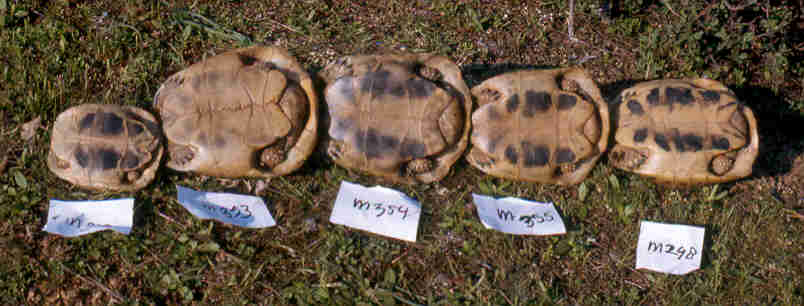 The Greek geographical situation is comparable
with that of the Galapagos island Isabela (Albemarle) where each of its five volcanos has a
different form of tortoise (Thornton, 1971). It is thus possible that similar morphologcal
differences would exist in Greek T. hermanni and perhaps in other Greek tortoise species
as well. Differences in body size and plastral pigmentation between western T. hermanni
(T. h. hermanni, formerly T. h. robermertensi) and the eastern T. hermanni
from the Balkans (T. h. boettgeri, formerly T. h. hermanni) were already described
by Wermuth (1952) and Stemmler (1963, 1968). In T. h. hermanni two bands of dark pigment
are found on the plastron (Tuscany, above) and the body size is smaller than in T. h. boettgeri.
In T. h. boettgeri spots of often diffuse pigment (Meteora, right) occur on the plastron, but
the pigmentation pattern in this subspecies is more variable than the western subspecies where
the two-banded pattern is found in almost all individuals.
The Greek geographical situation is comparable
with that of the Galapagos island Isabela (Albemarle) where each of its five volcanos has a
different form of tortoise (Thornton, 1971). It is thus possible that similar morphologcal
differences would exist in Greek T. hermanni and perhaps in other Greek tortoise species
as well. Differences in body size and plastral pigmentation between western T. hermanni
(T. h. hermanni, formerly T. h. robermertensi) and the eastern T. hermanni
from the Balkans (T. h. boettgeri, formerly T. h. hermanni) were already described
by Wermuth (1952) and Stemmler (1963, 1968). In T. h. hermanni two bands of dark pigment
are found on the plastron (Tuscany, above) and the body size is smaller than in T. h. boettgeri.
In T. h. boettgeri spots of often diffuse pigment (Meteora, right) occur on the plastron, but
the pigmentation pattern in this subspecies is more variable than the western subspecies where
the two-banded pattern is found in almost all individuals.
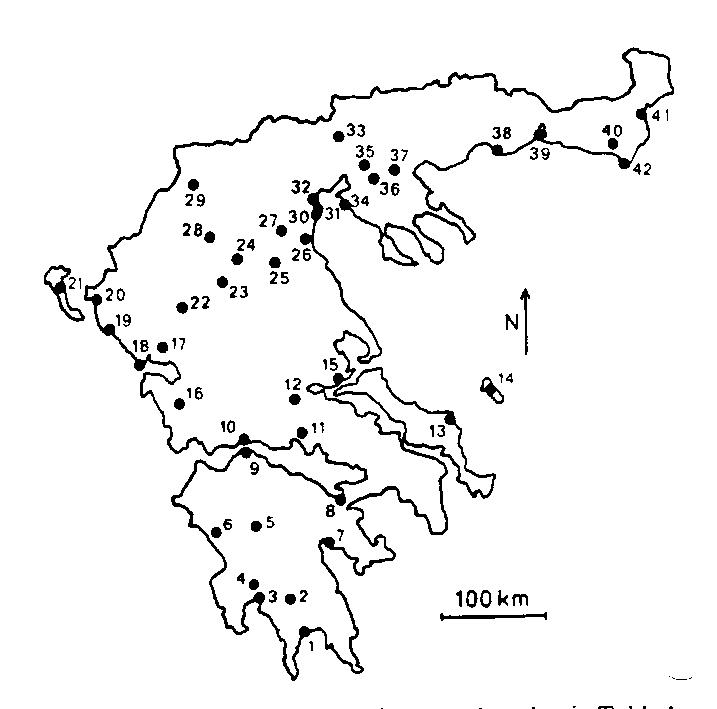 In 1975 the research in Greece began as a trial near Olympia. During that time it became clear
that the marking and recapture method was working well and that differences in plastral
pigmentation existed in that population. In the following years work was done at more sites
in Greece (Willemsen & Hailey, 1989). A correlation was found between latitude and altitude and
body size, with the largest animals found in northern Greece or at high altitude; in fact in the
coolest environments (Willemsen & Hailey, 1999a).
In 1975 the research in Greece began as a trial near Olympia. During that time it became clear
that the marking and recapture method was working well and that differences in plastral
pigmentation existed in that population. In the following years work was done at more sites
in Greece (Willemsen & Hailey, 1989). A correlation was found between latitude and altitude and
body size, with the largest animals found in northern Greece or at high altitude; in fact in the
coolest environments (Willemsen & Hailey, 1999a).
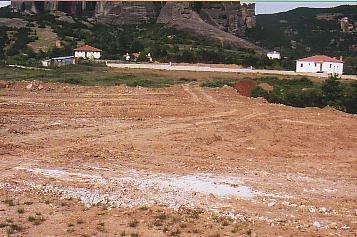 The quantity of plastral pigmentation decreased from the south to the north, but did not vary
with altitude (Willemsen & Hailey, 1999b). No significant
differences in carapace pigmentation were found between populations.
There was often, but not
always, a correlation between the quantity of plastral and carapace pigmentation; animals with
a dark carapace can have little pigmentation on the plastron and vice versa.
More information about body size and ecological differences can be found at:
http://www.ahailey.f9.co.uk/greece.htm, which also describes
conservation studies on Greek tortoise populations. The original research site at Olympia
was abandoned in the early 1980s after tortoises were killed by pesticides
(Willemsen & Hailey, 2001). The main research site
was then Meteora in central Greece. Parts of
this site have also been destroyed, by fire and mechanical clearance of the vegetation.
The area shown at the right had a high population density of T. hermanni
till 1984. The habitat was gradually degraded, and in in the last two years was completely
destroyed by flattening and house building. A fragment of the original habitat seen in the right
of the picture still had many tortoises in 2001 but was being filled with rubbish.
The quantity of plastral pigmentation decreased from the south to the north, but did not vary
with altitude (Willemsen & Hailey, 1999b). No significant
differences in carapace pigmentation were found between populations.
There was often, but not
always, a correlation between the quantity of plastral and carapace pigmentation; animals with
a dark carapace can have little pigmentation on the plastron and vice versa.
More information about body size and ecological differences can be found at:
http://www.ahailey.f9.co.uk/greece.htm, which also describes
conservation studies on Greek tortoise populations. The original research site at Olympia
was abandoned in the early 1980s after tortoises were killed by pesticides
(Willemsen & Hailey, 2001). The main research site
was then Meteora in central Greece. Parts of
this site have also been destroyed, by fire and mechanical clearance of the vegetation.
The area shown at the right had a high population density of T. hermanni
till 1984. The habitat was gradually degraded, and in in the last two years was completely
destroyed by flattening and house building. A fragment of the original habitat seen in the right
of the picture still had many tortoises in 2001 but was being filled with rubbish.
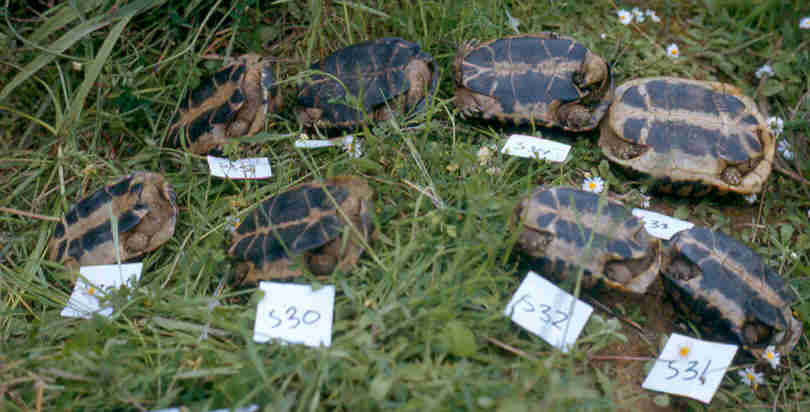 In addition to differences in the quantity of pigment on the plastron, there are also significant
differences in pigmentation patterns between populations, which could be useful for indentifying
the origin of a sample of tortoises. On the Peloponnese, southern Greece, T. hermanni is
small-sized and often with a heavily pigmented plastron (Willemsen & Hailey, 1999a,b). There
are large dark areas on the
plastron; two, often wide, bands of dense black pigment are found in most
animals (Sparta, left). A totally black (melanistic) plastron is frequently seen in all Peloponnese
T. hermanni populations. Diffuse plastral pigment, which is common in northern mainland
populations, is also found in all Peloponnese populations, but the pigmented area is in almost
all cases larger and darker than in northern populations.
In addition to differences in the quantity of pigment on the plastron, there are also significant
differences in pigmentation patterns between populations, which could be useful for indentifying
the origin of a sample of tortoises. On the Peloponnese, southern Greece, T. hermanni is
small-sized and often with a heavily pigmented plastron (Willemsen & Hailey, 1999a,b). There
are large dark areas on the
plastron; two, often wide, bands of dense black pigment are found in most
animals (Sparta, left). A totally black (melanistic) plastron is frequently seen in all Peloponnese
T. hermanni populations. Diffuse plastral pigment, which is common in northern mainland
populations, is also found in all Peloponnese populations, but the pigmented area is in almost
all cases larger and darker than in northern populations.
 Along the west coast of the Greek mainland T. hermanni is medium-sized (Willemsen
& Hailey, 1999a,b). Separated spots of black pigmentation are found on the plastron in most
animals (Parga, right). On the east coast, animals are also medium-sized with the spotted pattern of
the west coast, but the two-banded pattern is here more common than on the west coast.
In most animals the pigmented area is smaller than in
tortoises from the Peloponnese, for both black spots and bands. In both western and eastern
coastal populations a substantial number of animals were found with diffuse pigmentation.
Medium-sized T. hermanni are found in lower altitude areas of central Greece, and most
animals have spots of diffuse pigmentation on the plastron.
Along the west coast of the Greek mainland T. hermanni is medium-sized (Willemsen
& Hailey, 1999a,b). Separated spots of black pigmentation are found on the plastron in most
animals (Parga, right). On the east coast, animals are also medium-sized with the spotted pattern of
the west coast, but the two-banded pattern is here more common than on the west coast.
In most animals the pigmented area is smaller than in
tortoises from the Peloponnese, for both black spots and bands. In both western and eastern
coastal populations a substantial number of animals were found with diffuse pigmentation.
Medium-sized T. hermanni are found in lower altitude areas of central Greece, and most
animals have spots of diffuse pigmentation on the plastron.
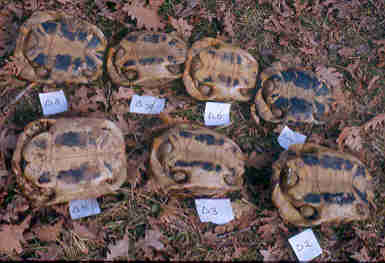 Animals with little or no pigmentation are common (see photo of 5 animals at Meteora - the
second tortoise figure above). In many animals the gular and anal
scutes lack pigmentation, and even animals with little or no pigment on the humeral and femoral
scutes occur. These animals, if they have more than some small spots of diffuse
pigmentation, have a small and short band of diffuse or dark pigment.
The pigment on the abdominal
scute is often radiating to the head, a pattern which is common in all populations in central
and northern Greece, but is extremely rare in southern Greece. In all populations individuals
with a coastal and even a southern pigmentation pattern were also found.
Large-bodied T. hermanni occur in northern Greece, as described at Deskati, Agios
Dimitrios and Kastoria, but
large animals are also common along the Albanian border between Neapolis and Eptachorion. This
type of tortoise was also found in the region around lake Ochrid and up to Skopje in the former
Yugoslavia. The patterns are like those in the medium-sized T. hermanni from central
Greece, but the short-band pattern is more common here (Deskati, left).
Animals with little or no pigmentation are common (see photo of 5 animals at Meteora - the
second tortoise figure above). In many animals the gular and anal
scutes lack pigmentation, and even animals with little or no pigment on the humeral and femoral
scutes occur. These animals, if they have more than some small spots of diffuse
pigmentation, have a small and short band of diffuse or dark pigment.
The pigment on the abdominal
scute is often radiating to the head, a pattern which is common in all populations in central
and northern Greece, but is extremely rare in southern Greece. In all populations individuals
with a coastal and even a southern pigmentation pattern were also found.
Large-bodied T. hermanni occur in northern Greece, as described at Deskati, Agios
Dimitrios and Kastoria, but
large animals are also common along the Albanian border between Neapolis and Eptachorion. This
type of tortoise was also found in the region around lake Ochrid and up to Skopje in the former
Yugoslavia. The patterns are like those in the medium-sized T. hermanni from central
Greece, but the short-band pattern is more common here (Deskati, left).
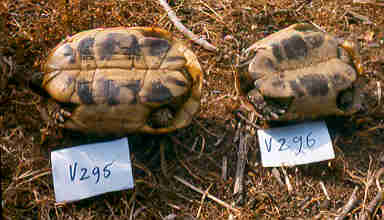 The T. hermanni populations in north-east Greece (Mikri Volvi and Keramoti) are also
large-sized (Willemsen & Hailey, 1999a,b), although those from Mikri Volvi are rather smaller than the
largest animals.
The T. hermanni populations in north-east Greece (Mikri Volvi and Keramoti) are also
large-sized (Willemsen & Hailey, 1999a,b), although those from Mikri Volvi are rather smaller than the
largest animals.
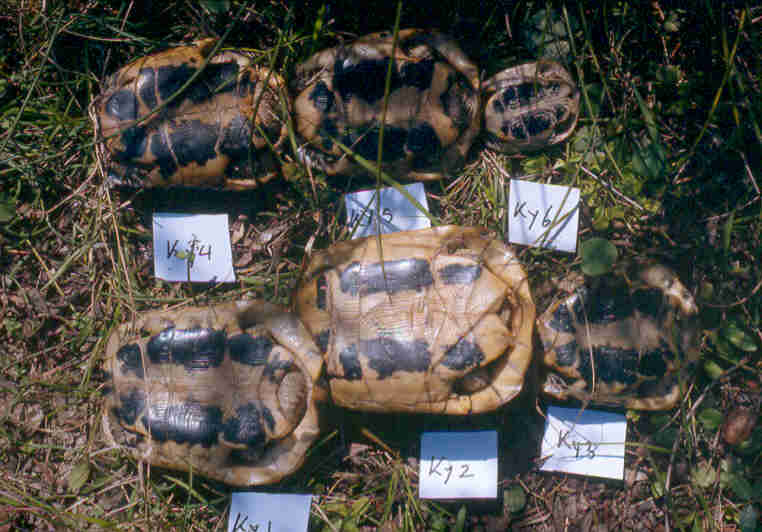 In these populations most animals have spots of diffuse pigment and unpigmented
animals are rather common (Mikri Volvi, right). T. hermanni from the island of Euboea seem to be
different from those of the Greek mainland.
Only a small sample was found on that island, so it
is difficult to say if these results are conclusive for that island. The males were small-sized
and with a dark plastron like those from the Peloponnese, while females were larger than
expected and less pigmented than those on the Peloponnese (Kymi, left).
The body size and plastral pigmentation patterns will make it possible to approximately
determine
the location of a sample of Greek T. hermanni and those from the south-western part of
the former Yugoslavia. For individuals this is only possible in a very crude way, for all types
of pigmentation are found in each population, although often very rare. But in adults the
combination of body size and pigmentation pattern will give an indication of the origin even for
one individual. Determination will only be possible in adult tortoises, for juveniles from all
populations are much the same.
In these populations most animals have spots of diffuse pigment and unpigmented
animals are rather common (Mikri Volvi, right). T. hermanni from the island of Euboea seem to be
different from those of the Greek mainland.
Only a small sample was found on that island, so it
is difficult to say if these results are conclusive for that island. The males were small-sized
and with a dark plastron like those from the Peloponnese, while females were larger than
expected and less pigmented than those on the Peloponnese (Kymi, left).
The body size and plastral pigmentation patterns will make it possible to approximately
determine
the location of a sample of Greek T. hermanni and those from the south-western part of
the former Yugoslavia. For individuals this is only possible in a very crude way, for all types
of pigmentation are found in each population, although often very rare. But in adults the
combination of body size and pigmentation pattern will give an indication of the origin even for
one individual. Determination will only be possible in adult tortoises, for juveniles from all
populations are much the same.
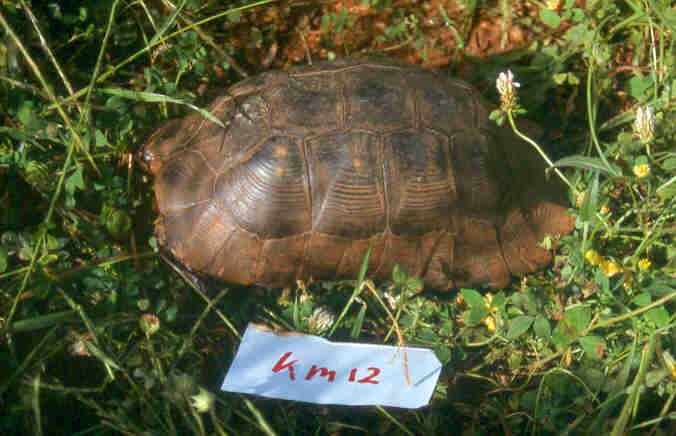 The morphology of T. marginata in Greece is puzzling. It is difficult to collect data
from a large sample of different populations, and numbers in a population are often small. It
seems that there could be a similar body size gradient as in T. hermanni in Greece,
but with a smaller range. In the south-western part of the
Peloponnese dwarf T. marginata are found (Bour, 1996; Artner, 1996). The real status of
these dwarf T. marginata is still unclear, but it is not excluded that they will be a
separate subspecies. There are no differences in pigmentation between T. maginata
populations. Pigmentation on the plastron does not change during life; carapace pigmentation
increases, then decreases again in old age (Bringsøe, Buskirk & Willemsen, 2001). No
morphological differences are found between Greek T. graeca populations.
The morphology of T. marginata in Greece is puzzling. It is difficult to collect data
from a large sample of different populations, and numbers in a population are often small. It
seems that there could be a similar body size gradient as in T. hermanni in Greece,
but with a smaller range. In the south-western part of the
Peloponnese dwarf T. marginata are found (Bour, 1996; Artner, 1996). The real status of
these dwarf T. marginata is still unclear, but it is not excluded that they will be a
separate subspecies. There are no differences in pigmentation between T. maginata
populations. Pigmentation on the plastron does not change during life; carapace pigmentation
increases, then decreases again in old age (Bringsøe, Buskirk & Willemsen, 2001). No
morphological differences are found between Greek T. graeca populations.
 On the mainland of Italy all T. hermanni populations are small and scattered and all
belong to the western subspecies T. h. hermanni (Bour,1987; Ballasina, 1995; Willemsen,
1990). Only in Tuscany and Latium are populations with high and medium density found. In
Campania, Calabria and Puglia small low density populations are still found. Almost all mainland
populations are threatened by development, illegal sampling, forest fires and by predation from
increasing populations of introduced central European wild boar (Sus scrofa).
It seems that there will be a similar geographical gradient in body size to the Greek
populations (Willemsen, 1990).
On the mainland of Italy all T. hermanni populations are small and scattered and all
belong to the western subspecies T. h. hermanni (Bour,1987; Ballasina, 1995; Willemsen,
1990). Only in Tuscany and Latium are populations with high and medium density found. In
Campania, Calabria and Puglia small low density populations are still found. Almost all mainland
populations are threatened by development, illegal sampling, forest fires and by predation from
increasing populations of introduced central European wild boar (Sus scrofa).
It seems that there will be a similar geographical gradient in body size to the Greek
populations (Willemsen, 1990).
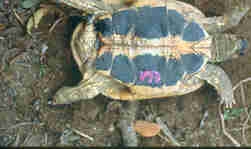 Animals from the lower altitude parts of Tuscany are small-sized,
compared to the Greek tortoises, and those from the higher parts are medium-sized. Animals from
Calabria are the smallest known T.hermanni (Willemsen, 1990). Adult females and males
are often hardly larger than 10 cm, the usual juvenile limit for T. hermanni. However,
the scattered and often very small and low density populations surviving today make it
impossible to construct a cline as for Greek T. hermanni.
Pigmentation is almost uniform in Italy. There are two bands of black pigment on the plastron,
similar to but often narrower than in the Peloponnese (Tuscany, above).
Few animals have spots of
diffuse pigment on the plastron or a totally black plastron. The carapace is more darkly
pigmented than in most of the Greek animals, but in some Greek populations dark animals are
also rather common. Strangely T. hermanni on Sicily and Sardinia are larger than those
of southern mainland Italy. Populations on Sicily have medium-sized animals
(Ballasina & Willemsen, unpublished data). In these populations the two-banded pigmentation
pattern is predominant (Sicily, right). The situation on Sardinia is puzzling as individuals as
large as the largest Greek tortoises are common (Fritz et al., 1996), but medium-sized animals
also occur. Plastral pigmentation is like the Sicilian and mainland Italian populations.
Animals from the lower altitude parts of Tuscany are small-sized,
compared to the Greek tortoises, and those from the higher parts are medium-sized. Animals from
Calabria are the smallest known T.hermanni (Willemsen, 1990). Adult females and males
are often hardly larger than 10 cm, the usual juvenile limit for T. hermanni. However,
the scattered and often very small and low density populations surviving today make it
impossible to construct a cline as for Greek T. hermanni.
Pigmentation is almost uniform in Italy. There are two bands of black pigment on the plastron,
similar to but often narrower than in the Peloponnese (Tuscany, above).
Few animals have spots of
diffuse pigment on the plastron or a totally black plastron. The carapace is more darkly
pigmented than in most of the Greek animals, but in some Greek populations dark animals are
also rather common. Strangely T. hermanni on Sicily and Sardinia are larger than those
of southern mainland Italy. Populations on Sicily have medium-sized animals
(Ballasina & Willemsen, unpublished data). In these populations the two-banded pigmentation
pattern is predominant (Sicily, right). The situation on Sardinia is puzzling as individuals as
large as the largest Greek tortoises are common (Fritz et al., 1996), but medium-sized animals
also occur. Plastral pigmentation is like the Sicilian and mainland Italian populations.
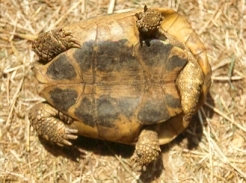 The situation is also puzzling on Corsica, where medium-sized and large-sized animals are found. The
larger animals have the shape of T. h. boettgeri (Joubert & Cheylan, 1989) but according
to plastron morphology they all belong to the western subspecies. The pigmentation pattern is
mixed. Some animals have the two-banded pattern of the western subspecies, others have spots of
often diffuse pigment like central Greek T. h. boettgeri populations (Corsica, left).
Along the Italian west coast scattered small populations of T. marginata are found. It
is likely that this species was introduced by the Etruscans, which is also likely to be
responsible for the populations on Sardinia. The Italian and Sardinian T. marginata are
often larger
than the Greek specimens (Ballasina & Willemsen, unpublished data). The status of the
T. graeca which occur on Sardinia (Ballasina, 1996; Buskirk,1996; Fritz et al., 1996)
is unclear. It is most likely that these populations have been introduced by man, but they
could have different sources; North Africa, Greece or Asia Minor.
The situation is also puzzling on Corsica, where medium-sized and large-sized animals are found. The
larger animals have the shape of T. h. boettgeri (Joubert & Cheylan, 1989) but according
to plastron morphology they all belong to the western subspecies. The pigmentation pattern is
mixed. Some animals have the two-banded pattern of the western subspecies, others have spots of
often diffuse pigment like central Greek T. h. boettgeri populations (Corsica, left).
Along the Italian west coast scattered small populations of T. marginata are found. It
is likely that this species was introduced by the Etruscans, which is also likely to be
responsible for the populations on Sardinia. The Italian and Sardinian T. marginata are
often larger
than the Greek specimens (Ballasina & Willemsen, unpublished data). The status of the
T. graeca which occur on Sardinia (Ballasina, 1996; Buskirk,1996; Fritz et al., 1996)
is unclear. It is most likely that these populations have been introduced by man, but they
could have different sources; North Africa, Greece or Asia Minor.
The classical taxonomy of tortoises is based on differences in shape, body size, structure
of the shell and skull, and coloration . Many of these characteristics could
have environmental causes, so taxonomy will always be questionable, especially at the level of
subspecies and below.
The new techniques of gene sequencing have opened the possibilty
to study differences in DNA and RNA, and comparing taxa at all levels, even individuals. The
costs of these analyses make it impossible to use large samples, which limit the results
in most research. Recently a study was made of the phylogenetic relationships among the species
of the genus Testudo using mitochondrial rRNA (van der Kuyl
et al., 2002).
This study confirms most, but not all, of the results of classical taxonomy.
 It is generally assumed, though not by herpetologists, that recent tortoises are ancient
animals, remainders of the era of the dinosaurs. But fossil records and the RNA analysis of all
living Testudo sp., the large African Geochelone sp. and the two South
American forest Geochelone sp. show that these are recent species on a geological
time scale. The evolution of the genus Testudo is monophyletic, as shown in the tree
cluster diagram. The earliest division of the Testudo group did not occur before the
middle of the miocene, about 20 million years ago, if a slow mutation rate of mitichondrial RNA
is assumed; if a fast rate is assumed then the division occurred in the villafranchian period
at the begining of the pleistocene, 2.6 million years ago. The miocene option looks the most
likely, for during that period the climate became drier and caused open landscapes with steppe
vegetiation, which is favourable to tortoises. These changes in climate and vegetation caused
an explosion of mammal species adapted to the new habitats. At that time there were also routes
passable by tortoises from Europe to Africa and the American continents. The fossil tortoise
record of Europe, Asia and America shows a rich variation of species in the miocene and pliocene,
often of very large size, which disappeared rapidly when the ancestors of man appeared.
It is generally assumed, though not by herpetologists, that recent tortoises are ancient
animals, remainders of the era of the dinosaurs. But fossil records and the RNA analysis of all
living Testudo sp., the large African Geochelone sp. and the two South
American forest Geochelone sp. show that these are recent species on a geological
time scale. The evolution of the genus Testudo is monophyletic, as shown in the tree
cluster diagram. The earliest division of the Testudo group did not occur before the
middle of the miocene, about 20 million years ago, if a slow mutation rate of mitichondrial RNA
is assumed; if a fast rate is assumed then the division occurred in the villafranchian period
at the begining of the pleistocene, 2.6 million years ago. The miocene option looks the most
likely, for during that period the climate became drier and caused open landscapes with steppe
vegetiation, which is favourable to tortoises. These changes in climate and vegetation caused
an explosion of mammal species adapted to the new habitats. At that time there were also routes
passable by tortoises from Europe to Africa and the American continents. The fossil tortoise
record of Europe, Asia and America shows a rich variation of species in the miocene and pliocene,
often of very large size, which disappeared rapidly when the ancestors of man appeared.
A second division occurred with separation of the ancestors of T. hermanni and T.
horsfieldii at the beginning of the pliocene about 11 million years ago; later if the
mutation rate is fast, about 1.4 million years ago in the pleistocene at the beginning of the
ice ages. The division of T. graeca was not before the pleistocene, 2.6
million years ago, and possibly as late as 0.3 million years ago between two ice ages.
 The
separation of T. marginata and T. kleinmanni occurred in the
pliocene, at the earliest 9 million years ago, or at the latest in the early pleistocene, 1.1
million years ago. It is likely that during the last ice age T. hermanni in western
Europe had only one small refugium in
the very south of Italy. From that refugium the species crept to the north and
colonized the coastal area of Italy and France. There are no real barriers for this species
along the Italian and French coast. A small ancestral stock of T. h. hermanni can
explain why this subspecies is so uniform; no population can be older than 10,000 years. It is
likely that there were more refugia in the Balkans during the last ice age, so this can explain
the larger variation in the Balkan subspecies, T. h. boettgeri.
It is also likely that all tortoise populations on islands such as Corsica, Sardinia and Mallorca
are human introductions. No morphological differences were found between T. h. hermanni
from Mallorca and Tuscany (unpublished data), but large differences were found between
T. hermanni from Sardinia and Corsica. Their body sizes are like the large animals of the
Balkans, but all their other morphology is like the western subspecies. If these populations
were introduced by man then it happened long ago and these animals had a rather fast evolution.
More samples and sequencing of different genes could give more detailed data about relationships
and migration of Mediterranean tortoises.
The
separation of T. marginata and T. kleinmanni occurred in the
pliocene, at the earliest 9 million years ago, or at the latest in the early pleistocene, 1.1
million years ago. It is likely that during the last ice age T. hermanni in western
Europe had only one small refugium in
the very south of Italy. From that refugium the species crept to the north and
colonized the coastal area of Italy and France. There are no real barriers for this species
along the Italian and French coast. A small ancestral stock of T. h. hermanni can
explain why this subspecies is so uniform; no population can be older than 10,000 years. It is
likely that there were more refugia in the Balkans during the last ice age, so this can explain
the larger variation in the Balkan subspecies, T. h. boettgeri.
It is also likely that all tortoise populations on islands such as Corsica, Sardinia and Mallorca
are human introductions. No morphological differences were found between T. h. hermanni
from Mallorca and Tuscany (unpublished data), but large differences were found between
T. hermanni from Sardinia and Corsica. Their body sizes are like the large animals of the
Balkans, but all their other morphology is like the western subspecies. If these populations
were introduced by man then it happened long ago and these animals had a rather fast evolution.
More samples and sequencing of different genes could give more detailed data about relationships
and migration of Mediterranean tortoises.
References
Artner, H. (1996). Beobachtungen and der Zwerg-Breitrandschildkröte Testudo weissingeri in Messenien/Griechenland und Diskussion über die Validität ihres Artstatus. Emys 3, 2-5.
Ballasina, D. (1995). Distribuzione e situazione delle tartarughe terresstri in Italia. In BALLASINA, D. (Hrsg.): Red data book on Mediterranean Chelonians. Bolognia (Ediagricole), pp 147-168.
Ballasina, D. (1996). Conservation and reproduction techniques at the Carapax Center, Italy. In: Proceedings of the International Congress of Chelonian Conservation , Gonfaron, 6th July 1995. Gonfaron (SOPTOM), pp 210-213.
Bour, R. (1987). L'identité des tortues terrestres européennes: spécimens-types et localités-types. Rev. Fr. Aquariol. 13, 111-122.
Bour, R. (1996). Une nouvelle espèce de tortue terrestre dans le Peloponnèse (grèce). Dumerilia 2, 23-54.
Bringsøe, H., Buskirk, J. & Willemsen, R. E. (2001). Handbuch der Reptilien and Amphibien Europas. Testudo marginata Schoepff, 1792 - Breitrandschildkröte. Herausgegeben von Uwe Fritz. AULA-Verlag Wiebelheim.
Buskirk, J. (1996). On the absence of spur-tighted tortoises, Testudo graeca, from Egypt. Chelon. Conserv. Biol. 2, 118-120.
Darwin, C. (1859). The origin of species. John Murray, London.
Fritz, U., Petters, G. W. & Matzanke, M. (1996). Zur Schildkrötenfauna Nordsardiniens, Teil 2 Herpetofauna 18, 5-14.
Joubert, L. & Cheylan, M. (1989). La tortue d'Hermann de Corse. Trav. Sci. parc. Nat. Reg., Rés. Nat. de Corse 22, 1-54.
Stemmler, O. (1968). Zur Kenntnis von Testudo hermanni in tyrrhenischen Gebiet. Aquar. Terrar. 7, 49-52.
Stemmler-Gyger, O. (1963). Ein Beitrag zur Brutbiologie der mediterranen Landschildkröten. Aquar. Terrar. Z. 16, 181-183.
Thornton, I. (1971). Darwin's Islands: A natural History of the Galapágos. The Natural History Press. Garden City, New York.
van der Kuyl, A. C., Ballasina, D. L. P., Dekker, J. T., Maas, J., Willemsen, R. E. &
Goudsmit, J. (2002). Phylogenetic relationships among the species of the genus Testudo
(Testudines: Testudinidae) inferred from mitochondrial 12S rRNA gene sequences. Mol. Phylog.
Evol. 22, 174-183. abstract
Wermuth, H. (1952). Testudo hermanni robertmertensi n. subsp. und ihr Vorkommen in Spanien.Senckenbergiana 33, 157-164.
Willemsen, R. E. (1990). The status of Testudo hermanni hermanni in southern Tuscany (Province Grosseteo and Livorno) WWF of Tuscany. Firenze.
Willemsen, R. E. & Hailey, A. (1989). Status and conservation of tortoises in Greece. Herpetol. J. 1, 315-330. abstract
Willemsen, R. E. & Hailey, A. (1999a). Variation of adult body size of the tortoise Testudo hermanni in Greece: proximate and ultimate causes. J. Zool. Lond. 248, 379-396. abstract
Willemsen, R. E. & Hailey, A. (1999b). A latitudinal cline of dark plastral pigmentation in the tortoise Testudo hermanni in Greece. Herpetol. J. 9, 125-132. abstract
Willemsen, R. E. & Hailey, A. (2001). Effects of spraying the herbicides 2,4-D and 2,4,5-T on a population of the tortoise Testudo hermanni in southern Greece. Environ. Pollut. 113: 71-78. abstract
With Geochelone sulcata at the Centro Carapax, Italy. Other interests include model
ship building. The steel four-masted barque Herzogin Cecilie was built in Germany in 1902
and wrecked at Ham Stone, Devon in 1936. The model is now in a museum at Åland, Finland.
Other models:
 In the Balkans Testudo hermanni is the most common tortoise species. It is found all
over Greece from sea level to up 1500 metres in the mountains of the Peloponnese
(Willemsen & Hailey, 1989).
Greece is divided into many
regions, each with different climatic conditions and habitats, by mountain ridges which are
impassable (or only with difficulty) by tortoises.
In the Balkans Testudo hermanni is the most common tortoise species. It is found all
over Greece from sea level to up 1500 metres in the mountains of the Peloponnese
(Willemsen & Hailey, 1989).
Greece is divided into many
regions, each with different climatic conditions and habitats, by mountain ridges which are
impassable (or only with difficulty) by tortoises.
 The Greek geographical situation is comparable
with that of the Galapagos island Isabela (Albemarle) where each of its five volcanos has a
different form of tortoise (Thornton, 1971). It is thus possible that similar morphologcal
differences would exist in Greek T. hermanni and perhaps in other Greek tortoise species
as well. Differences in body size and plastral pigmentation between western T. hermanni
(T. h. hermanni, formerly T. h. robermertensi) and the eastern T. hermanni
from the Balkans (T. h. boettgeri, formerly T. h. hermanni) were already described
by Wermuth (1952) and Stemmler (1963, 1968). In T. h. hermanni two bands of dark pigment
are found on the plastron (Tuscany, above) and the body size is smaller than in T. h. boettgeri.
In T. h. boettgeri spots of often diffuse pigment (Meteora, right) occur on the plastron, but
the pigmentation pattern in this subspecies is more variable than the western subspecies where
the two-banded pattern is found in almost all individuals.
The Greek geographical situation is comparable
with that of the Galapagos island Isabela (Albemarle) where each of its five volcanos has a
different form of tortoise (Thornton, 1971). It is thus possible that similar morphologcal
differences would exist in Greek T. hermanni and perhaps in other Greek tortoise species
as well. Differences in body size and plastral pigmentation between western T. hermanni
(T. h. hermanni, formerly T. h. robermertensi) and the eastern T. hermanni
from the Balkans (T. h. boettgeri, formerly T. h. hermanni) were already described
by Wermuth (1952) and Stemmler (1963, 1968). In T. h. hermanni two bands of dark pigment
are found on the plastron (Tuscany, above) and the body size is smaller than in T. h. boettgeri.
In T. h. boettgeri spots of often diffuse pigment (Meteora, right) occur on the plastron, but
the pigmentation pattern in this subspecies is more variable than the western subspecies where
the two-banded pattern is found in almost all individuals.
 In 1975 the research in Greece began as a trial near Olympia. During that time it became clear
that the marking and recapture method was working well and that differences in plastral
pigmentation existed in that population. In the following years work was done at more sites
in Greece (Willemsen & Hailey, 1989). A correlation was found between latitude and altitude and
body size, with the largest animals found in northern Greece or at high altitude; in fact in the
coolest environments (
In 1975 the research in Greece began as a trial near Olympia. During that time it became clear
that the marking and recapture method was working well and that differences in plastral
pigmentation existed in that population. In the following years work was done at more sites
in Greece (Willemsen & Hailey, 1989). A correlation was found between latitude and altitude and
body size, with the largest animals found in northern Greece or at high altitude; in fact in the
coolest environments ( The quantity of plastral pigmentation decreased from the south to the north, but did not vary
with altitude (
The quantity of plastral pigmentation decreased from the south to the north, but did not vary
with altitude ( In addition to differences in the quantity of pigment on the plastron, there are also significant
differences in pigmentation patterns between populations, which could be useful for indentifying
the origin of a sample of tortoises. On the Peloponnese, southern Greece, T. hermanni is
small-sized and often with a heavily pigmented plastron (Willemsen & Hailey, 1999a,b). There
are large dark areas on the
plastron; two, often wide, bands of dense black pigment are found in most
animals (Sparta, left). A totally black (melanistic) plastron is frequently seen in all Peloponnese
T. hermanni populations. Diffuse plastral pigment, which is common in northern mainland
populations, is also found in all Peloponnese populations, but the pigmented area is in almost
all cases larger and darker than in northern populations.
In addition to differences in the quantity of pigment on the plastron, there are also significant
differences in pigmentation patterns between populations, which could be useful for indentifying
the origin of a sample of tortoises. On the Peloponnese, southern Greece, T. hermanni is
small-sized and often with a heavily pigmented plastron (Willemsen & Hailey, 1999a,b). There
are large dark areas on the
plastron; two, often wide, bands of dense black pigment are found in most
animals (Sparta, left). A totally black (melanistic) plastron is frequently seen in all Peloponnese
T. hermanni populations. Diffuse plastral pigment, which is common in northern mainland
populations, is also found in all Peloponnese populations, but the pigmented area is in almost
all cases larger and darker than in northern populations. Along the west coast of the Greek mainland T. hermanni is medium-sized (Willemsen
& Hailey, 1999a,b). Separated spots of black pigmentation are found on the plastron in most
animals (Parga, right). On the east coast, animals are also medium-sized with the spotted pattern of
the west coast, but the two-banded pattern is here more common than on the west coast.
In most animals the pigmented area is smaller than in
tortoises from the Peloponnese, for both black spots and bands. In both western and eastern
coastal populations a substantial number of animals were found with diffuse pigmentation.
Medium-sized T. hermanni are found in lower altitude areas of central Greece, and most
animals have spots of diffuse pigmentation on the plastron.
Along the west coast of the Greek mainland T. hermanni is medium-sized (Willemsen
& Hailey, 1999a,b). Separated spots of black pigmentation are found on the plastron in most
animals (Parga, right). On the east coast, animals are also medium-sized with the spotted pattern of
the west coast, but the two-banded pattern is here more common than on the west coast.
In most animals the pigmented area is smaller than in
tortoises from the Peloponnese, for both black spots and bands. In both western and eastern
coastal populations a substantial number of animals were found with diffuse pigmentation.
Medium-sized T. hermanni are found in lower altitude areas of central Greece, and most
animals have spots of diffuse pigmentation on the plastron.
 Animals with little or no pigmentation are common (see photo of 5 animals at Meteora - the
second tortoise figure above). In many animals the gular and anal
scutes lack pigmentation, and even animals with little or no pigment on the humeral and femoral
scutes occur. These animals, if they have more than some small spots of diffuse
pigmentation, have a small and short band of diffuse or dark pigment.
The pigment on the abdominal
scute is often radiating to the head, a pattern which is common in all populations in central
and northern Greece, but is extremely rare in southern Greece. In all populations individuals
with a coastal and even a southern pigmentation pattern were also found.
Large-bodied T. hermanni occur in northern Greece, as described at Deskati, Agios
Dimitrios and Kastoria, but
large animals are also common along the Albanian border between Neapolis and Eptachorion. This
type of tortoise was also found in the region around lake Ochrid and up to Skopje in the former
Yugoslavia. The patterns are like those in the medium-sized T. hermanni from central
Greece, but the short-band pattern is more common here (Deskati, left).
Animals with little or no pigmentation are common (see photo of 5 animals at Meteora - the
second tortoise figure above). In many animals the gular and anal
scutes lack pigmentation, and even animals with little or no pigment on the humeral and femoral
scutes occur. These animals, if they have more than some small spots of diffuse
pigmentation, have a small and short band of diffuse or dark pigment.
The pigment on the abdominal
scute is often radiating to the head, a pattern which is common in all populations in central
and northern Greece, but is extremely rare in southern Greece. In all populations individuals
with a coastal and even a southern pigmentation pattern were also found.
Large-bodied T. hermanni occur in northern Greece, as described at Deskati, Agios
Dimitrios and Kastoria, but
large animals are also common along the Albanian border between Neapolis and Eptachorion. This
type of tortoise was also found in the region around lake Ochrid and up to Skopje in the former
Yugoslavia. The patterns are like those in the medium-sized T. hermanni from central
Greece, but the short-band pattern is more common here (Deskati, left). The T. hermanni populations in north-east Greece (Mikri Volvi and Keramoti) are also
large-sized (Willemsen & Hailey, 1999a,b), although those from Mikri Volvi are rather smaller than the
largest animals.
The T. hermanni populations in north-east Greece (Mikri Volvi and Keramoti) are also
large-sized (Willemsen & Hailey, 1999a,b), although those from Mikri Volvi are rather smaller than the
largest animals.
 In these populations most animals have spots of diffuse pigment and unpigmented
animals are rather common (Mikri Volvi, right). T. hermanni from the island of Euboea seem to be
different from those of the Greek mainland.
Only a small sample was found on that island, so it
is difficult to say if these results are conclusive for that island. The males were small-sized
and with a dark plastron like those from the Peloponnese, while females were larger than
expected and less pigmented than those on the Peloponnese (Kymi, left).
The body size and plastral pigmentation patterns will make it possible to approximately
determine
the location of a sample of Greek T. hermanni and those from the south-western part of
the former Yugoslavia. For individuals this is only possible in a very crude way, for all types
of pigmentation are found in each population, although often very rare. But in adults the
combination of body size and pigmentation pattern will give an indication of the origin even for
one individual. Determination will only be possible in adult tortoises, for juveniles from all
populations are much the same.
In these populations most animals have spots of diffuse pigment and unpigmented
animals are rather common (Mikri Volvi, right). T. hermanni from the island of Euboea seem to be
different from those of the Greek mainland.
Only a small sample was found on that island, so it
is difficult to say if these results are conclusive for that island. The males were small-sized
and with a dark plastron like those from the Peloponnese, while females were larger than
expected and less pigmented than those on the Peloponnese (Kymi, left).
The body size and plastral pigmentation patterns will make it possible to approximately
determine
the location of a sample of Greek T. hermanni and those from the south-western part of
the former Yugoslavia. For individuals this is only possible in a very crude way, for all types
of pigmentation are found in each population, although often very rare. But in adults the
combination of body size and pigmentation pattern will give an indication of the origin even for
one individual. Determination will only be possible in adult tortoises, for juveniles from all
populations are much the same. The morphology of T. marginata in Greece is puzzling. It is difficult to collect data
from a large sample of different populations, and numbers in a population are often small. It
seems that there could be a similar body size gradient as in T. hermanni in Greece,
but with a smaller range. In the south-western part of the
Peloponnese dwarf T. marginata are found (Bour, 1996; Artner, 1996). The real status of
these dwarf T. marginata is still unclear, but it is not excluded that they will be a
separate subspecies. There are no differences in pigmentation between T. maginata
populations. Pigmentation on the plastron does not change during life; carapace pigmentation
increases, then decreases again in old age (Bringsøe, Buskirk & Willemsen, 2001). No
morphological differences are found between Greek T. graeca populations.
The morphology of T. marginata in Greece is puzzling. It is difficult to collect data
from a large sample of different populations, and numbers in a population are often small. It
seems that there could be a similar body size gradient as in T. hermanni in Greece,
but with a smaller range. In the south-western part of the
Peloponnese dwarf T. marginata are found (Bour, 1996; Artner, 1996). The real status of
these dwarf T. marginata is still unclear, but it is not excluded that they will be a
separate subspecies. There are no differences in pigmentation between T. maginata
populations. Pigmentation on the plastron does not change during life; carapace pigmentation
increases, then decreases again in old age (Bringsøe, Buskirk & Willemsen, 2001). No
morphological differences are found between Greek T. graeca populations. Animals from the lower altitude parts of Tuscany are small-sized,
compared to the Greek tortoises, and those from the higher parts are medium-sized. Animals from
Calabria are the smallest known T.hermanni (Willemsen, 1990). Adult females and males
are often hardly larger than 10 cm, the usual juvenile limit for T. hermanni. However,
the scattered and often very small and low density populations surviving today make it
impossible to construct a cline as for Greek T. hermanni.
Pigmentation is almost uniform in Italy. There are two bands of black pigment on the plastron,
similar to but often narrower than in the Peloponnese (Tuscany, above).
Few animals have spots of
diffuse pigment on the plastron or a totally black plastron. The carapace is more darkly
pigmented than in most of the Greek animals, but in some Greek populations dark animals are
also rather common. Strangely T. hermanni on Sicily and Sardinia are larger than those
of southern mainland Italy. Populations on Sicily have medium-sized animals
(Ballasina & Willemsen, unpublished data). In these populations the two-banded pigmentation
pattern is predominant (Sicily, right). The situation on Sardinia is puzzling as individuals as
large as the largest Greek tortoises are common (Fritz et al., 1996), but medium-sized animals
also occur. Plastral pigmentation is like the Sicilian and mainland Italian populations.
Animals from the lower altitude parts of Tuscany are small-sized,
compared to the Greek tortoises, and those from the higher parts are medium-sized. Animals from
Calabria are the smallest known T.hermanni (Willemsen, 1990). Adult females and males
are often hardly larger than 10 cm, the usual juvenile limit for T. hermanni. However,
the scattered and often very small and low density populations surviving today make it
impossible to construct a cline as for Greek T. hermanni.
Pigmentation is almost uniform in Italy. There are two bands of black pigment on the plastron,
similar to but often narrower than in the Peloponnese (Tuscany, above).
Few animals have spots of
diffuse pigment on the plastron or a totally black plastron. The carapace is more darkly
pigmented than in most of the Greek animals, but in some Greek populations dark animals are
also rather common. Strangely T. hermanni on Sicily and Sardinia are larger than those
of southern mainland Italy. Populations on Sicily have medium-sized animals
(Ballasina & Willemsen, unpublished data). In these populations the two-banded pigmentation
pattern is predominant (Sicily, right). The situation on Sardinia is puzzling as individuals as
large as the largest Greek tortoises are common (Fritz et al., 1996), but medium-sized animals
also occur. Plastral pigmentation is like the Sicilian and mainland Italian populations. The situation is also puzzling on Corsica, where medium-sized and large-sized animals are found. The
larger animals have the shape of T. h. boettgeri (Joubert & Cheylan, 1989) but according
to plastron morphology they all belong to the western subspecies. The pigmentation pattern is
mixed. Some animals have the two-banded pattern of the western subspecies, others have spots of
often diffuse pigment like central Greek T. h. boettgeri populations (Corsica, left).
Along the Italian west coast scattered small populations of T. marginata are found. It
is likely that this species was introduced by the Etruscans, which is also likely to be
responsible for the populations on Sardinia. The Italian and Sardinian T. marginata are
often larger
than the Greek specimens (Ballasina & Willemsen, unpublished data). The status of the
T. graeca which occur on Sardinia (Ballasina, 1996; Buskirk,1996; Fritz et al., 1996)
is unclear. It is most likely that these populations have been introduced by man, but they
could have different sources; North Africa, Greece or Asia Minor.
The situation is also puzzling on Corsica, where medium-sized and large-sized animals are found. The
larger animals have the shape of T. h. boettgeri (Joubert & Cheylan, 1989) but according
to plastron morphology they all belong to the western subspecies. The pigmentation pattern is
mixed. Some animals have the two-banded pattern of the western subspecies, others have spots of
often diffuse pigment like central Greek T. h. boettgeri populations (Corsica, left).
Along the Italian west coast scattered small populations of T. marginata are found. It
is likely that this species was introduced by the Etruscans, which is also likely to be
responsible for the populations on Sardinia. The Italian and Sardinian T. marginata are
often larger
than the Greek specimens (Ballasina & Willemsen, unpublished data). The status of the
T. graeca which occur on Sardinia (Ballasina, 1996; Buskirk,1996; Fritz et al., 1996)
is unclear. It is most likely that these populations have been introduced by man, but they
could have different sources; North Africa, Greece or Asia Minor.  It is generally assumed, though not by herpetologists, that recent tortoises are ancient
animals, remainders of the era of the dinosaurs. But fossil records and the RNA analysis of all
living Testudo sp., the large African Geochelone sp. and the two South
American forest Geochelone sp. show that these are recent species on a geological
time scale. The evolution of the genus Testudo is monophyletic, as shown in the tree
cluster diagram. The earliest division of the Testudo group did not occur before the
middle of the miocene, about 20 million years ago, if a slow mutation rate of mitichondrial RNA
is assumed; if a fast rate is assumed then the division occurred in the villafranchian period
at the begining of the pleistocene, 2.6 million years ago. The miocene option looks the most
likely, for during that period the climate became drier and caused open landscapes with steppe
vegetiation, which is favourable to tortoises. These changes in climate and vegetation caused
an explosion of mammal species adapted to the new habitats. At that time there were also routes
passable by tortoises from Europe to Africa and the American continents. The fossil tortoise
record of Europe, Asia and America shows a rich variation of species in the miocene and pliocene,
often of very large size, which disappeared rapidly when the ancestors of man appeared.
It is generally assumed, though not by herpetologists, that recent tortoises are ancient
animals, remainders of the era of the dinosaurs. But fossil records and the RNA analysis of all
living Testudo sp., the large African Geochelone sp. and the two South
American forest Geochelone sp. show that these are recent species on a geological
time scale. The evolution of the genus Testudo is monophyletic, as shown in the tree
cluster diagram. The earliest division of the Testudo group did not occur before the
middle of the miocene, about 20 million years ago, if a slow mutation rate of mitichondrial RNA
is assumed; if a fast rate is assumed then the division occurred in the villafranchian period
at the begining of the pleistocene, 2.6 million years ago. The miocene option looks the most
likely, for during that period the climate became drier and caused open landscapes with steppe
vegetiation, which is favourable to tortoises. These changes in climate and vegetation caused
an explosion of mammal species adapted to the new habitats. At that time there were also routes
passable by tortoises from Europe to Africa and the American continents. The fossil tortoise
record of Europe, Asia and America shows a rich variation of species in the miocene and pliocene,
often of very large size, which disappeared rapidly when the ancestors of man appeared. 
